Letters from Lodi
An insightful and objective look at viticulture and winemaking from the Lodi
Appellation and the growers and vintners behind these crafts. Told from the
perspective of multi-award winning wine journalist, Randy Caparoso.
Head vs. vertical cordon trained old vines, and the skilled labor behind it
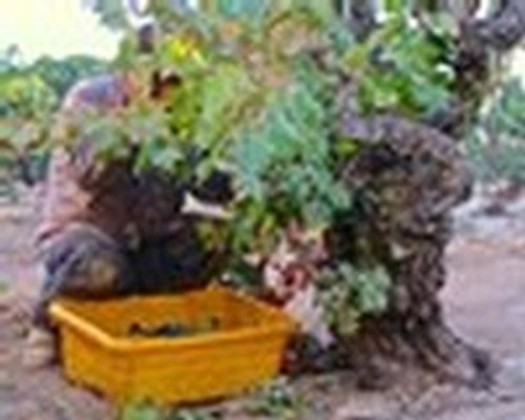
2020 harvest of 105-year-old, head-trained Zinfandel on the east side of Lodi's Mokelumne River AVA
Lodi, more than any other American wine region, is full of old vines. Or as we have been calling on everyone to appreciate this phenomenon in our most recent campaign: Save the Old!
It is commonly assumed that all the free-standing old vines, supported by single stakes rather than trellis wires, in the Lodi Viticultural Area, are what are called "head-trained, spur-pruned" vines. Many of these old vine plantings, however, are more properly called "spur pruned, vertical cordon" trained vines.
The difference is this:
• Head-trained vines are trained so that all the spurs, or permanent arms, are positioned around the top or "head" of the trunk, which is usually no more than a foot or two from the ground.
• Vertical cordon-trained vines are also supported by a stake and spur pruned like head-trained vines, only their spurs are positioned up and down the trunk — i.e., the vertically growing, single cordon — at intervals anywhere from a foot or as much as 5 or 6 feet off the ground.
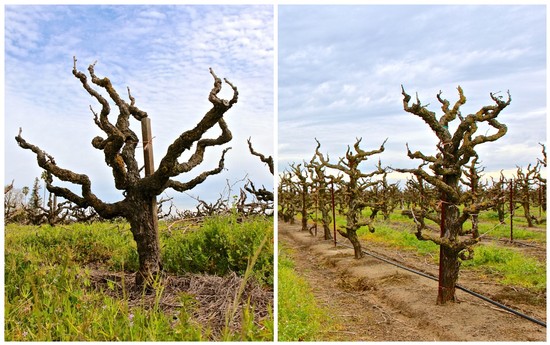
Comparison of two types of spur-pruned vines farmed in the Lodi AVA: on the left, head-trained Zinfandel (Burness Vineyard); and on the right, vertical cordon-trained Zinfandel (TruLux Vineyard)
Prior to the 1920s, most of Lodi's vineyards were planted as head-trained vines. However, Lodi's oldest vineyard — the 25-acre Bechthold Vineyard, planted on its own natural roots in 1886 —actually consists of quasi-head trained/vertical cordon vines: their spurs are positioned on their trunks on at least two levels, rather than from a single head. Why? Because given the site, distinguished by extremely deep yet vigorous sandy loam soil, and the cultivar (the generously yielding Cinsaut grape) to which it is planted, the number of spur positions on each vine has proven to be the perfect balance for this particular growth. It is the reason why Bechthold Vineyard has thrived for over 134 years.
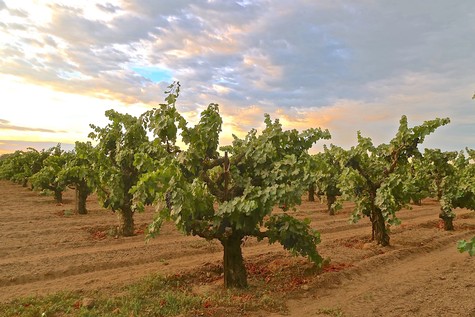
Quasi-head/vertical cordon-trained Cinsaut vines in Lodi's historic Bechthold Vineyard
Most of Lodi's spur-pruned vineyards planted after the 1950s have been vertical cordon vines, rather than head trained. The big advantage of vertical cordon training, especially on trunks as high as 5 or 6 feet, is the potential for more spur positions, and thus higher yields. During the 1960s and '70s, when many Lodi growers began to move away from own-rooted plantings in favor of grafting vines on more vigorous rootstocks, such as Freedom and Dogridge, vertical cordon training became the logical choice. The differences in yields between a typical head-trained vineyard and a typical vertical cordon-trained vineyard might be 4-5 tons per acre vs. 8-10 tons per acre.
Vertical cordon-trained Zinfandel plantings were an especially big advantage during the 1980s and 1990s when light, fruity White Zinfandel became the fastest-growing domestic wine category. When picking grapes for White Zinfandel, the name of the game has always been quantity, not quality, as grapes going into White Zinfandel are also picked at lower sugars than grapes meant for red Zinfandel. The other objective of higher-yielding vertical cordon plantings, of course, has been to meet the needs of White Zinfandel price points, which are always well below $10; and lower-priced wines require lower-priced grapes grown in higher-yielding vineyards.
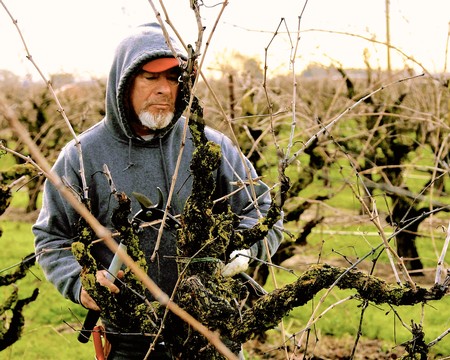
Winter pruning of vertical cordon-trained Zinfandel on Lodi's west side
Historical usage of head-trained vines
In the 1850s and 1860s, when pioneering California vintners first began planting grapes in Sonoma County, Napa Valley, the Santa Cruz Mountains, Amador County, or, of course, the Lodi AVA, they planted virtually everything as head-trained, spur-pruned vines.
This style of vine training is said to date back to the ancient Egyptians and Romans, and it is still practiced throughout Southern France and Spain today. The French called this goblet, translated as “goblet,” in reference to the shape of the vine when spurs are trained from the top of a short, single trunk. Gobelet vines are typically pruned back during winter months, leaving buds or nodes at the top of each spur for the growth of, usually, two new canes from each spur in early spring. In places like Australia, where a commercial wine industry was started in the 1820s, they have always used the term “bush vine” for goblet or head-trained vines, since vines trained in this way resemble small bushes or shrubs.
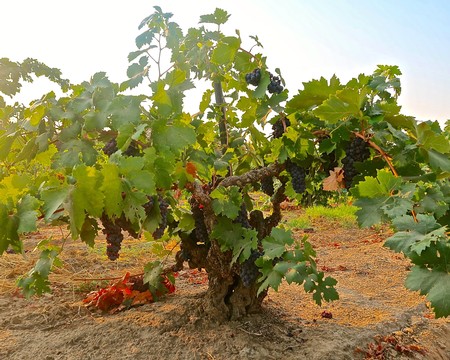
Classic "small vine" configuration of goblet (i.e., head trained, spur pruned) trained Zinfandel in Clements Hills-Lodi's Süss Vineyard (planted in the late 1920s)
Head or goblet-style training made sense for the early Californians between the 1850s and the 1920s because of the intrinsic "small vine" factor of this style of grapevine husbandry. That is to say, vines with, say, no more than 6 to 8 spur positions have less vegetative growth, and thus require little or no irrigation — a big advantage during an era requiring dry farming, especially in lower vigor sites such as the foothills of the Sierra Nevada, or shallow, gravelly benchlands in Napa Valley or Sonoma County.
At the same time, the small vine configuration of head training has proven equally successful in higher vigor sites in Lodi, which historically have always had more access to water via furrow irrigation from canals fed by the Mokelumne River, as well as by dint of higher water tables. The "self-regulating" nature of small, head-trained vines has also worked well in Lodi's numerous heritage vineyards, dominated by deep (i.e., no hardpan, even at 30- to 50-foot depths), well-drained, sandy loam soils.
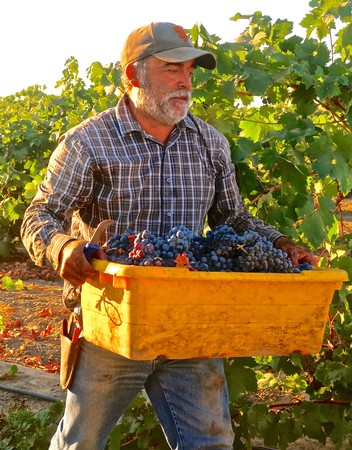
Zinfandel picker in east side Mokelumne River-Lodi vineyard over 100 years old
California's oldest existing commercial vineyard is probably the 1853 Deaver Ranch Mission grape plantings in Amador County. Amador County is also where you can find Zinfandel blocks dating as far back as 1869. Records show that commercial wine and table grape plantings in Lodi began in earnest in the 1860s, particularly to supply Stockton's El Pinal Winery (est. 1858), which also maintained a commercial nursery that furnished cuttings of dozens of European grape varieties.
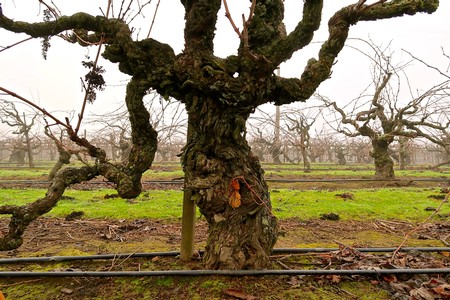
Head-trained Zinfandel in Jessie's Grove's Royal Tee Vineyard (planted 1889), where spurs have grown as long or longer than the vines' trunks
Here is a short list of the years when Lodi's oldest surviving vineyards, still productive after over 100 years, were planted, along with how their vines are trained:
• 1886 (Bechthold Vineyard Cinsaut) — quasi-head trained/vertical cordon vines
• 1889 (Jessie's Grove's Royal Tee Zinfandel field mix) — head-trained vines
• 1896 (Peirano Estate Zinfandel) — head-trained vines
• Mid- to late-1890s (Chandler Vineyard Flame Tokay, originally planted by Zella Hansen) — vertical cordon vines
• 1900 (Jessie's Grove's Block 4 Carignan) — vertical cordon vines
• 1901 (Mohr-Fry Ranches' Marian's Vineyard Zinfandel, originally planted by a branch of the Mettlers) — head-trained vines
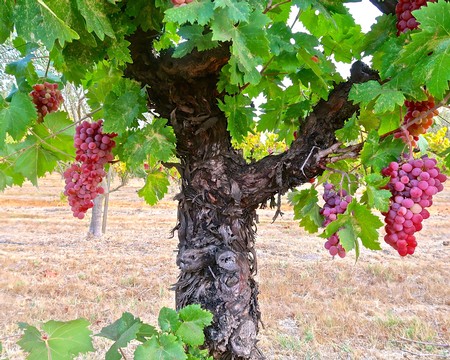
Tall, vertical cordon trained Flame Tokay in Chandler Vineyard (planted in the mid-to-late-1890s)
In Lodi, in fact, there are still thousands of acres of pre-1960s head or vertical cordon-trained vines, most of them planted on their own roots, despite the current shrinking demand for grapes for the White Zinfandel and value-priced ($10 and under) Zinfandel markets. These vineyards are planted primarily in Zinfandel, with smaller numbers planted in Carignan, Grenache, Alicante Bouschet, Mission, and of course, Cinsaut.
Quality advantages (and disadvantages) of spur-pruned vines
Progressive Viticulture's Stan Grant, who has been furnishing viticultural advisory to grape growers in San Joaquin County for over 30 years, recently came out with an industry-targeted article published by lodigrowers.com, talking about the advantages of head-trained vines and why it is still strongly favored by the wine industry, especially for the production of premium quality Zinfandel.
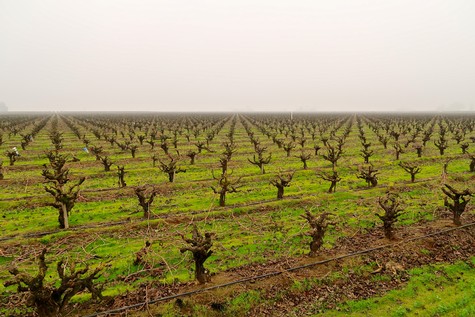
Small head trained vines in Lodi's 300-acre Peirano Estate
According to Grant, it is the "uniformity" of spur positions in head-trained vines that is “one of the key ingredients to exceptional winegrape quality.” The gnarly growth of the vines itself is a positive factor, says Grant: “The many twists and turns of the permanent woody framework and the vascular tissues within create resistances to the ascent of sap inside head-trained vines. This may enhance their tolerance for water stress compared to vines trained more simply, like those formed as bilateral cordons.”
As head-trained or goblet-trained vines grow older — as much as over 75 or 100 years old in regions like Lodi — the spurs themselves often become as long or longer as the vines' trunks. Says Grant, “Taller goblet training reduces the risk of frost damage compared to shorter goblet training. It also allows greater distances for shoots to drape before reaching the ground. The benefits of expanded shoot draping include greater exposed leaf area per vine and associated ripening capacity, reduced requirement of hedging to keep shoots off the vineyard floor, and with appropriate shoot thinning to conserve the shoot density set during pruning, increased fruit zone aeration and reduced foliar disease.”
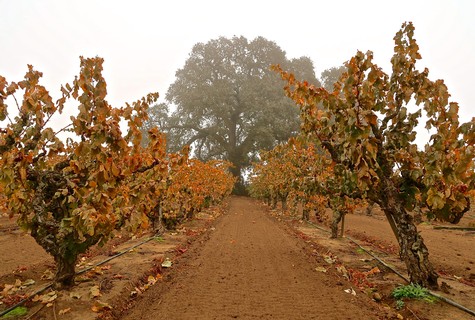
Vertical cordon trained ancient vine Carignan (planted 1900) in Jessie's Grove's Block 4 on Lodi's west side
With respect to vertical cordon-trained vines, says Grant, “While... more expeditious and less labor intensive than goblet training, it has a major inherent disadvantage.... [vertical cordon trained] grapevines display the apical dominance phenomena, in which organs, such as shoots, at higher positions acquire a greater share of vine resources at the expense of organs at lower positions. Consequently, shoots at higher positions on vertical cordons grow and develop more rapidly than those at lower positions... and the differences between higher and lower positions on vertical cordons become greater over time.”
All the same, there are a number of individual vertical cordon-trained vineyards in Lodi that have forged stellar reputations for strongly distinctive witnesses. Examples include the moderate-sized vertical cordoned Zinfandel in Maley Bros.'s Wegat Vineyard on North Ray Road, the 6-foot-high Zinfandel vines in Maley on Lucas Road Vineyard (at West Woodbridge Road), and the equally tall Zinfandel in Keith Watts’ TruLux Vineyard, the latter producing a string of McCay Cellars’ most consistent wines over the past 20 years.
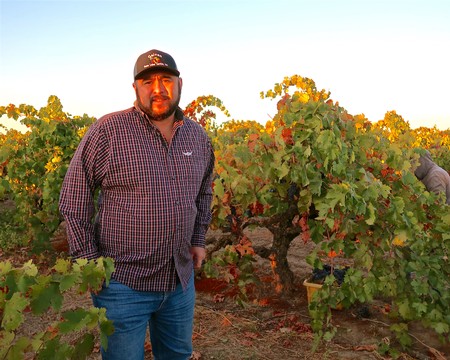
Galvan Farming Services' Alex Lopez
Old vines as fruits of equally specialized labor
If there is one huge disadvantage to spur-pruned vines, whether head or vertical cordon trained, it is with respect to labor: These vineyards are not conducive to anything less than pruning, thinning, or harvesting by hand. Many, many skilled hands. It is the rising cost of manually cultivating these vines that, more than anything, is putting them closer to extinction by the day.
A recent conversation with Alex Lopez — who works with Mario Galvan and his Galvan Farming Services, which supplies much of the labor for Lodi area vineyards management companies — shed light on an important part of the equation, amounting to what makes spur-pruned vines irreplaceable in the premium wine industry.
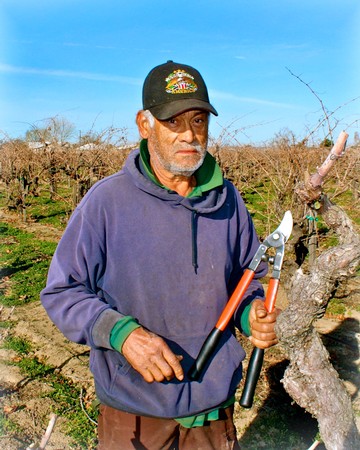
Highly skilled, veteran hand on the west side of Lodi's Mokelumne River AVA
According to Lopez:
With all this recent talk about Old Vines, and what they mean to consumers and to the Lodi wine industry in general, one thing that has been missing from the discussions is the relationship between the Old Vines and the people who take care of them. I'm talking about our laborers, the farm hands. Many of them are people who have been working with these vines for years. In many cases, for generations, like my own family. Like the vineyard owners, they have formed deep and lasting relationships with these vines.
The vineyard owners know that without the unique skill sets of our laborers, these Old Vines do not exist. To successfully farm these vineyards, it takes people who know exactly how it's done. As everyone knows, it's not an anyone-can-do-it thing. But what you also can't overlook is the fact that these people care just as much about these Old Vines as the people who own these vineyards or the people who drink the wines from these vines. It's a strong emotional connection.
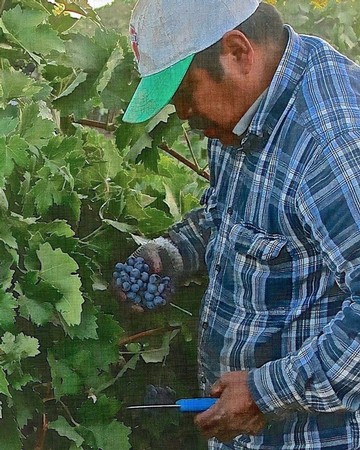
Zinfandel picker in east side Lodi vineyard planted in the early 1900s
Working these vineyards is hard and tedious work, and it's year after year after year. But all our people say the same thing: They really don't want to see these Old Vines disappear either. They come out and tell me — how much they love and respect these vines, especially the oldest ones. So it's not just a rare skill that they are offering or something that gets them a paycheck all year round. The Old Vines are a major part of their lives. These people, in other words, are as much a part of what makes Lodi special as the Old Vines themselves!
All the more reason to better understand what makes these Old Vines tick, and to appreciate them while they are still there.
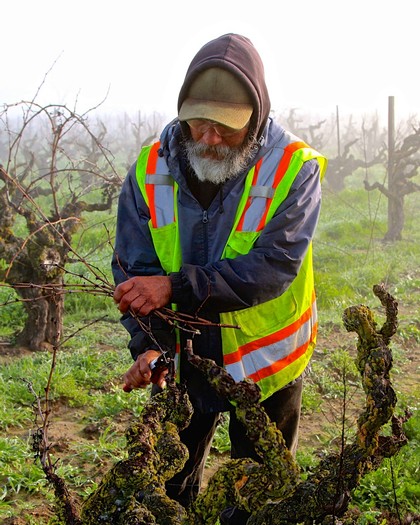
Winter pruning of head-trained vines in Lodi's Kirschenmann Vineyard (planted 1915)